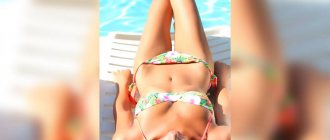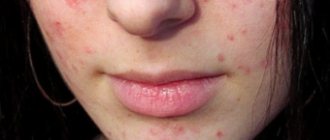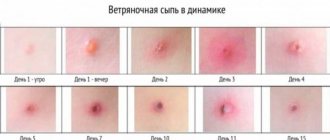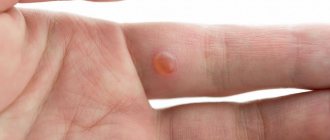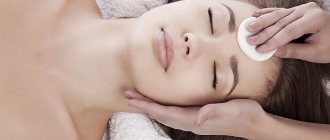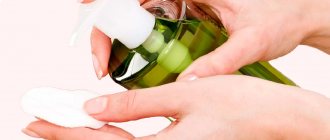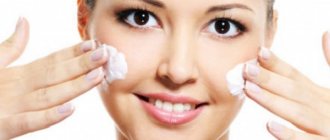Allergies and dermatitis are quite common problems in children. They can be provoked by a large number of external irritants, since the child’s body is not yet strong and is vulnerable.
One of the main methods of therapy is the use of ointments. They are hormonal and non-hormonal. This option is preferable for children, since it has a more gentle effect.
Don't self-medicate! Be sure to consult with a qualified healthcare practitioner. The information is for informational purposes only and does not replace medical care.
Can it be used in childhood?
The advantage of non-hormonal drugs is that they can be used from a very early age , even for infants for whom hormonal drugs are contraindicated.
The drugs act gently, relieve inflammation and unpleasant symptoms, and have a minimum of contraindications and side effects.
Usually these are the ones prescribed to children - hormonal medications are indicated when the situation is advanced, and non-hormonal medications do not give results.
In what cases are non-hormonal drugs used?
Drugs in this category have almost no contraindications and can be used for a long time. Among the most effective are the following:
- panthenol-containing – moisturize the skin, promote the healing of microcracks and minor damage;
- lanolin-containing – soften the skin, relieve pain and irritation;
- retinol-containing – stimulate skin regeneration processes;
- ointments containing local antihistamines are prescribed for insect bites and severe skin irritation.
Operating principle, selection criteria
Non-hormonal ointments usually consist of natural ingredients. They have a gentle effect, help relieve inflammation, itching, burning, eliminate rashes, and other negative consequences of an allergic reaction.
Many of them have antibacterial and antifungal effects . They are able to stop the progression of the inflammatory process and prevent the spread of the rash throughout the body.
Despite the safety of non-hormonal drugs, a doctor should select them for a child. It takes into account the severity of the lesion, its cause - the choice of drug will depend on this.
If the lesion is extensive and serious, then such ointments are not enough.
Skin-cap, Bepanten, Elidel, Gistan, Fenistil gel and others with a similar spectrum of action can be prescribed for children.
There are times when it is necessary to use antibacterial ointments with antimicrobial action. Then the doctor may prescribe Dioxidin or Sulfargin or proven drugs - zinc or ichthyol ointment.
Complications of urticaria
In addition to Quincke's edema, there is another threat - anaphylactic shock. This is a severe allergic reaction that can be fatal. There are several forms of anaphylaxis, and each of them has different symptoms (severe headache, abdominal complaints, and others).
If you have the slightest suspicion of an emergency, you should call a doctor as soon as possible. Treatment of mild forms of allergies does not cause difficulties: the patient is injected with adrenaline, a glucocorticosteroid, an IV is placed - and the critical situation passes.
If action is not taken quickly, the person may fall into a coma or even die.
What else can cause hives?
To avoid allergies more successfully, you need to think about every little thing that could cause reactions. For example, if you visit a restaurant and immediately or a few hours later your skin begins to itch, papules and blisters appear, then the first suspicions will fall on the food consumed in the establishment.
Allergens can be hidden in spices and seasonings, ready-made mixtures, complex cocktails, and store-bought semi-finished products. After the first episode of hypersensitivity, it is important for you to prevent new episodes, and also to always remember what and where you did, drank, ate, smelled, touched.
Rating of antiallergic drugs
From a very early age, for children with allergies, the following anti-allergic non-hormonal ointments can be prescribed :
- Fenistil. A gel with a pronounced antipruritic effect, which helps relieve irritation caused by an allergic skin reaction, has a local anesthetic effect.
Can be used for urticaria, eczema, dermatoses, insect bites, burns that provoke itchy skin. Permitted for use from one month.
Please note that you should not apply it to large areas of the skin, especially if there is severe inflammation or bleeding.
It is important to avoid direct sunlight. The average price is 360-530 rubles.
- Gistan. This remedy should not be confused with Gistan-N, which is hormonal. This drug is a dietary supplement based on vegetable oils, extracts, dimethicone and betulin.
Used for allergic reactions on the skin with itching, urticaria, blistering rashes, eczema, neurodermatitis. Designed for outdoor use.
The only contraindications are an allergic reaction to the components of the drug. On average it costs about 200 rubles.
- Elidel. The main active component is pimecrolimus, which has a mild anti-inflammatory effect for eczema and atopic dermatitis. It is used for children over three months of age by applying to the affected areas.
During treatment, it is important to minimize ultraviolet exposure. Cost - from 840 rubles.
- Desitin. An ointment for external use that creates a protective barrier to prevent the spread of the rash. The main active substance is zinc oxide.
Please note that the drug should not be applied to infected areas of the skin. The price is 250 rubles.
For dermatitis (including atopic) children are prescribed the following non-hormonal ointments:
- Ichthyol ointment. Has a good absorbent effect, helps eliminate the feeling of itching, get rid of dermatitis.
However, a number of doctors believe that the anti-inflammatory effect of the ointment is not sufficiently expressed, which can slow down treatment. But in some cases it is still prescribed. Costs from 43 rubles.
- Radevit and Videstim. Contains vitamin A, which is necessary for the child’s body.
Radevit contains vitamins E and D. It is prescribed to children from three years of age.Vidistim has a milder effect and can be shown even to the smallest.
Price - from 200 rubles.
- Ointments and creams such as Bepanten and its analogues: Panthenol, Pantoderm, D-Panthenol are indicated for combating dry skin with dermatitis, for preventive care.
They help accelerate regeneration processes. Price - 150-500 rubles.
For atopic dermatitis, the doctor may prescribe the following ointments :
- Protopic. The main active component of the ointment is tacrolimus. Used to treat atopic dermatitis. Children are allowed ointment 0.03% and only from two years of age.
Protopic has a strong anti-inflammatory effect and, unlike a number of hormonal drugs, does not provoke skin atrophy. Costs about 1200-1600 rubles.
- Thymogen. The drug stimulates local immunity and accelerates recovery. The active substance is thymogen. Can be used for atopic dermatitis accompanied by secondary infection.
It is recommended to use 2 grams once a day. Use until symptoms disappear, but no more than 20 days. Price - from 280 rubles.
- Zinc ointment. Helps to get rid of inflammation and heal the rash in a short time. However, it is not recommended for very dry skin that is prone to flaking and roughness. Before application, thoroughly clean and dry the skin.
The drug is used up to six times a day with an interval of two hours. You can apply it at night and leave it on until the morning.
The drug is contraindicated if you are intolerant to zinc oxide. Price - from 30 rubles.
- Heparin ointment. Contains sodium heparin, benzocaine and benzyl nicotinate. Heparin is released on the skin gradually and relieves inflammation.
Benzocaine helps relieve pain. The product is applied in small quantities to the skin 2-3 times a day. Usually the course of treatment is 3-7 days, if necessary it is extended.
Contraindications include intolerance to components, violations of skin integrity and ulcerative-necrotic processes. Price - from 40 rubles.
Prevalence of atopic dermatitis in children
It is safe to say that this disease can occur in any country, in both males and females. Dermatitis occurs in different age categories. The prevalence of AD is higher in residents of economically developed countries, which may be due to the urban lifestyle of this population. According to the protocol for the treatment of AD in children, the prevalence of this pathology in the Russian Federation ranges from 6 to 15% according to ISSAC. ISAAC is a standardized epidemiological study - the International Study of Asthma and Allergy in Childhood. Repeated studies within the framework of this program show a significant increase in the prevalence of AD in children of the Russian Federation.
Research shows a significant increase in the prevalence of atopic dermatitis in children in the Russian Federation.
Also, the expert committee on asthma and allergy of the WHO European Bureau developed and approved another program - GA2LEN. GA2LEN (Global Allergy and Asthma European Network) studied the incidence of allergic pathology among adolescents aged 15 to 18 years. According to the study, the presence of symptoms of AD occurred in 33% of adolescents, the prevalence of AD according to questionnaires was 10%, and a confirmed diagnosis was found in 7% of adolescents. Girls have 1.5 times more than boys.
Contraindications for use
about contraindications to a specific drug in the instructions for it . Unlike hormonal ointments, formulations that do not contain hormones have no contraindications.
They are based on natural ingredients, but an allergic reaction to them is possible, for example, to various herbs. A number of ointments are contraindicated in case of violations of the integrity of the skin or excessive dryness.
Medicines can provoke adverse reactions, which include irritation, redness, dry skin, and rashes. If you notice them, be sure to consult your doctor.
Read the article about the selection and use of popular antifungal ointments for children:
- Clotrimazole - for all types of candidiasis localized on the skin surface;
- Pimafukort - to combat infectious and inflammatory diseases of the epidermis;
- Akriderm - for the treatment of skin diseases in children;
- Nystatinova - to prevent the development of fungus, including in childhood.
Check yourself: classic symptoms of urticaria
- First, pink or red itchy spots appear on the skin, which are covered with papules, vesicles, and blisters. Spots can migrate and change.
- These angioedema can be of any shape and size and are prone to coalescence and combing. Traumatization of the epidermis is accompanied by infection, the development of dermatitis, and the addition of various microflora (bacteria, fungi).
- Severe itching occurs, but with each touch of the affected area, the urticaria becomes more pronounced.
- Sometimes the body temperature rises, aches and headaches occur.
- The disease can be complicated by Quincke's edema: difficulty breathing, swallowing, nausea, vomiting, increased lip volume, swelling of the eyes, and then the entire face, which only increases. Mucous membranes are pasty, loose, swollen.
If anaphylaxis begins to develop, it is important to urgently call an ambulance.
Urticaria in children sometimes occurs without other symptoms other than changes in the skin, but more often develops after the onset of exudative diathesis. The likelihood of developing pathology is higher in children who receive artificial feeding and some foods that are not yet appropriate for them by age.
